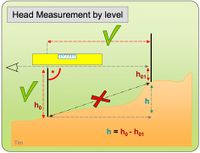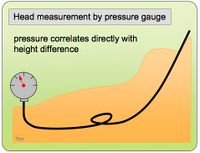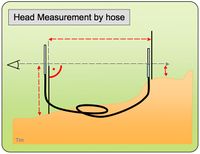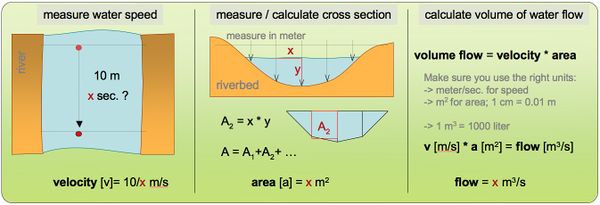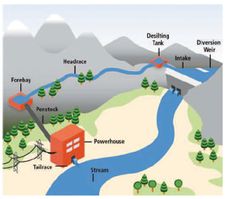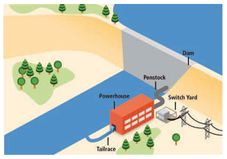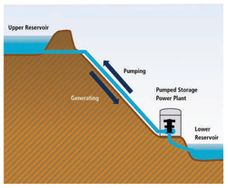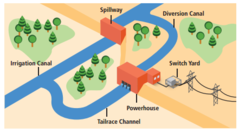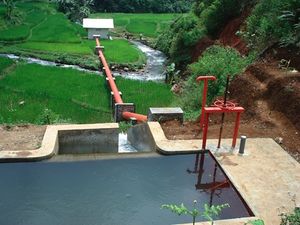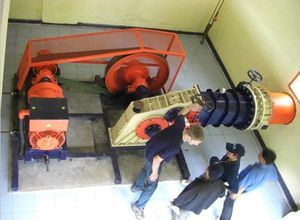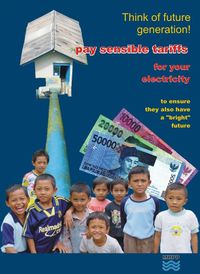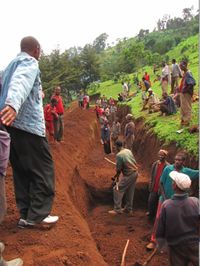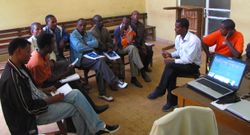Knowledge fuels change - Support energypedia!
For over 10 years, energypedia has been connecting energy experts around the world — helping them share knowledge, learn from each other, and accelerate the global energy transition.
Today, we ask for your support to keep this platform free and accessible to all.
Even a small contribution makes a big difference! If just 10–20% of our 60,000+ monthly visitors donated the equivalent of a cup of coffee — €5 — Energypedia would be fully funded for a whole year.
Is the knowledge you’ve gained through Energypedia this year worth €5 or more?
Your donation keeps the platform running, helps us create new knowledge products, and contributes directly to achieving SDG 7.
Thank you for your support, your donation, big or small, truly matters!
Difference between revisions of "Hydro Power Basics"
***** (***** | *****) m (/* By Facility Typehttp://srren.ipcc-wg3.de/report - Prepared by Working Group III of the Intergovernmental Panel on Climate Change [O. Edenhofer, R. Pichs-Madruga, Y. Sokona, K. Seyboth, P. Matschoss, S. Kadner, T. Zwickel, P. Eickemeier, G. Hans...) |
***** (***** | *****) m |
||
| (18 intermediate revisions by 9 users not shown) | |||
| Line 1: | Line 1: | ||
| − | [[Portal:Hydro|► Back to Hydro Portal]] | + | [[Portal:Hydro|► Back to Hydro Portal]]<br/> |
| − | = Overview | + | = Overview = |
| − | A mass of water moving down a height difference contains energy | + | A mass of water moving down a height difference contains energy which can be harvested using some waterwheel or turbine. The moving water drives the waterwheel and this rotation either drives machinery directly (e.g. mill, pump, hammer, thresher, ...) or is coupled with a generator which produces electric power. |
| − | + | <br/> | |
| + | |||
| + | {{#widget:YouTube|id=q8HmRLCgDAI}}<br/> | ||
| + | |||
| + | = Principle of Hydro Power = | ||
| + | |||
| + | Hydro power is probably the first form of automated power production which is not human / animal driven. Moving a grind stone for milling first, developed into the driving of an electrical generator. Next to steam it was for long the main power source for electricity.Its continual availability does not require any power storage (unlike [[Portal:Wind|wind]] / [[Portal:Solar|solar power]]). It is mainly mechanical hardware. This makes it relative easy to understand and repair-/maintainable. In smaller units its environmental impact becomes neglect-able (see: [[Hydro - Environmental Impact Assessment (EIA)|environmental impact assessment]] and [[Micro Hydro Power (MHP) - Pros and Cons|pros and cons of micro hydropower]]). | ||
| + | |||
| + | <br/> | ||
| − | + | = Head & Flow = | |
<u>In order to create electricity from hydropower, two parameters are critical:</u><br/> | <u>In order to create electricity from hydropower, two parameters are critical:</u><br/> | ||
| + | |||
*'''Flow'''; or the minimum amount of water that is constantly available throughout the entire year | *'''Flow'''; or the minimum amount of water that is constantly available throughout the entire year | ||
*'''Head'''; the difference in height<br/> | *'''Head'''; the difference in height<br/> | ||
| − | These specific conditions limit generalising and standartisation of "how to install hydropower plants". Choosing the right location and planning requires some specific knowledge. With knowledge of water flow and height difference the potential power can be estimated.<br/> | + | These specific conditions limit generalising and standartisation of "how to install hydropower plants". Choosing the right location and planning requires some specific knowledge. With knowledge of water flow and height difference the potential power can be estimated. <br /> |
| − | + | == Measuring Head & Flow == | |
| − | + | <u><span>The first step to judge a sites hydropower potential is to measure/estimate head and flow.</span></u><br/> | |
| − | |||
*<span>Head (the vertical distance between the intake and turbine)</span> | *<span>Head (the vertical distance between the intake and turbine)</span> | ||
*Flow (how much water comes down the stream) | *Flow (how much water comes down the stream) | ||
| Line 30: | Line 38: | ||
Wrong data occurs frequently. Confirmation of existing data is '''highly recommended'''! | Wrong data occurs frequently. Confirmation of existing data is '''highly recommended'''! | ||
| − | <span>Head and flow are the two most important facts of a hydro site. This will determine everything about the hydro | + | <span>Head and flow are the two most important facts of a hydro site. This will determine everything about the hydro system - volume of civil constructions, pipeline size, turbine type and power output. </span>Inaccurate measurements result in low efficiency, high cost and scarcity of power. |
<br/> | <br/> | ||
| + | |||
*For sophisticated methods how to inquire a sites feasibility, please check the [[Micro Hydro Power (MHP) Manuals|Manuals]] section. | *For sophisticated methods how to inquire a sites feasibility, please check the [[Micro Hydro Power (MHP) Manuals|Manuals]] section. | ||
*"[[:File:Laymans book - how to develop a small hydro site 128-266.pdf|Layman's book: How to develop a Small Hydro Site]]" may be a good start. | *"[[:File:Laymans book - how to develop a small hydro site 128-266.pdf|Layman's book: How to develop a Small Hydro Site]]" may be a good start. | ||
| Line 38: | Line 47: | ||
<br/> | <br/> | ||
| − | + | == Methods of Head and Flow Measurement without Sophisticated Tools == | |
| + | |||
| + | *'''<u><span style="font-weight: bold">E</span>stimation of height</u>''' can be done easiest if there is a steep slope (waterfall) by rope. | ||
<br/> | <br/> | ||
| − | + | <u>Principle of a step by step head measurement:</u><br/> | |
| − | + | [[File:Head measurement.jpg|thumb|center|600px|Head measurement.jpg]] | |
| − | |||
| − | [[File:Head measurement.jpg|thumb|center|600px| | ||
<br/> | <br/> | ||
| Line 54: | Line 63: | ||
<br/> | <br/> | ||
| − | {| | + | {| style="width: 500px" cellspacing="1" cellpadding="5" border="0" align="center" |
|- | |- | ||
| − | | [[File:Height measure by level.jpg|thumb|left|200px| | + | | [[File:Height measure by level.jpg|thumb|left|200px|Height measure by level.jpg]]<br/> |
| − | | [[File:Head by pressure gauge.jpg|thumb|left|200px| | + | | [[File:Head by pressure gauge.jpg|thumb|left|200px|Head by pressure gauge.jpg]]<br/> |
| − | | [[File:Height measure by hose.jpg|thumb|left|200px| | + | | [[File:Height measure by hose.jpg|thumb|left|200px|Height measure by hose.jpg]]<br/> |
|} | |} | ||
<br/> | <br/> | ||
| − | <u>'''Estimation of flow'''</u> is very difficult without measurement. A quick and easy way to measure is the '''floating method'''<br/> | + | *<u>'''Estimation of flow'''</u> is very difficult without measurement. |
| + | |||
| + | <br/> | ||
| + | |||
| + | <u>A quick and easy way to measure is the '''floating method''':</u><br/> | ||
| − | <u>First</u>, measure the waters speed at an steady flowing part of the river. Therefore drop some item and stop the time it needs for a certain distance to float. <u>Second</u>, do a sketch of the rivers cross section by measuring its depth every 20-50 cm so you come up with a grid showing the rivers profile from side to side. With this data its cross sections area can be calculated easily. <u>Finally</u> the flow volume results from (water) speed x (section) area. | + | #<u>First</u>, measure the waters speed at an steady flowing part of the river. Therefore drop some item and stop the time it needs for a certain distance to float. |
| + | #<u>Second</u>, do a sketch of the rivers cross section by measuring its depth every 20-50 cm so you come up with a grid showing the rivers profile from side to side. With this data its cross sections area can be calculated easily. | ||
| + | #<u>Finally</u> the flow volume results from (water) speed x (section) area. | ||
<br/> | <br/> | ||
| − | [[File:Flow measurement.jpg|thumb|center|600px| | + | [[File:Flow measurement.jpg|thumb|center|600px|Flow measurement.jpg]] |
<br/> | <br/> | ||
| Line 79: | Line 94: | ||
<br/> | <br/> | ||
| − | <u>To estimate a sites '''potential cost''' its necessary to know additionally:</u><br/> | + | *<u>To estimate a sites '''potential cost''' its necessary to know additionally:</u><br/><ul style="margin-left: 40px;"> |
| − | + | </ul> | |
| − | + | <li>Pipeline (penstock) length</li> | |
| − | + | <li>Electrical transmission line length (from turbine to consumer). As smaller the sites power output as higher the power lines cost share</li> | |
| + | <li>Number of potential customers</li> | ||
| + | |||
| + | [[Hydro Power Basics#toc|►Go to Top]] | ||
<br/> | <br/> | ||
| − | [[ | + | == Units and Power Estimations == |
| + | |||
| + | Power: watts [W] or Kilowatts [kW] 1 kW = 1000W<br/>Flow: 1 m³/s = 1000 l/s<br/>Gross heat: height difference the water "falls down"<br/>Net head: a little smaller than gross head. Gross head deducted by energy loss due to friction in penstock | ||
| + | |||
| + | <br/> | ||
| − | = | + | <u>'''Potential power ('''electric)'''''' is calculated as follows:</u><br/>Power [W] = Net head [m] x Flow [ l/s] x 9.81 [m/s²] (est. gravity constant) x 0.5 (turbine/generator efficiency)<br/>Potential power is <u>estimated</u> as follows:<br/>Power output [W] = height [m] * flow [l/s] * 5 |
| − | + | <br/> | |
| − | ''' | + | <u>'''More accurate estimations''' take into consideration:</u> |
| − | |||
*exact net head (intake to powerhouse) | *exact net head (intake to powerhouse) | ||
*exact flow (constant during the year?) | *exact flow (constant during the year?) | ||
*combined efficiency of turbine and generator (depends on quality, est. 60% = 0.6) | *combined efficiency of turbine and generator (depends on quality, est. 60% = 0.6) | ||
| − | + | <br/> | |
| − | <br/> | + | '''Example:'''<br/>A 6 m high waterfall has 300 liter/sec => potential power est. : 6 m * 300 l/s * 5 = 9000 W = 9 kW |
[[Hydro Power Basics#toc|►Go to Top]] | [[Hydro Power Basics#toc|►Go to Top]] | ||
| − | = Classification of Hydro Power | + | <br/> |
| + | |||
| + | = Classification of Hydro Power = | ||
== By Size == | == By Size == | ||
| Line 113: | Line 136: | ||
For the [http://www.unido.org/ United Nations Industrial Development Organization (UNIDO)] and the [http://www.esha.be/ European Small Hydropower Association (ESHA)] and the [http://cbip.org/iash/iash.html International Association for Small Hydro (IASH)] a capacity of up to '''10''' '''MW''' total is becoming the generally accepted norm for '''small hydropower plants (SHP)'''. In China, it can refer to capacities of up to 25 MW, in India up to 15 MW and in Sweden small means up to 1.5 MW, in Canada 'small' can refer to upper limit capacities of between 20 and 25 MW, and in the United States 'small' can mean 30 MW.<br/> | For the [http://www.unido.org/ United Nations Industrial Development Organization (UNIDO)] and the [http://www.esha.be/ European Small Hydropower Association (ESHA)] and the [http://cbip.org/iash/iash.html International Association for Small Hydro (IASH)] a capacity of up to '''10''' '''MW''' total is becoming the generally accepted norm for '''small hydropower plants (SHP)'''. In China, it can refer to capacities of up to 25 MW, in India up to 15 MW and in Sweden small means up to 1.5 MW, in Canada 'small' can refer to upper limit capacities of between 20 and 25 MW, and in the United States 'small' can mean 30 MW.<br/> | ||
| − | The German Federal Ministry for Environment, Nature Conservation and Nuclear Safety mentioned that a SHP is < 1 MW, everything above is a large hydro electric plant and usually comes along with a large dam. The | + | The German Federal Ministry for Environment, Nature Conservation and Nuclear Safety mentioned that a SHP is <1 MW, everything above is a large hydro electric plant and usually comes along with a large dam. The [http://www.icold-cigb.org/ International Commission on Large Dams (ICOLD)] defines a large dam as a dam with a height of 15 m or more from the foundation. If dams are between 5-15 m high and have a reservoir volume of more than 3 million m<sup>3</sup>, they are also classified as large dams. Using this definition, there are over 45 000 large dams around the world.<br/> |
<br/> | <br/> | ||
| Line 119: | Line 142: | ||
<u>Small hydro can be further subdivided into mini, micro and pico:</u> | <u>Small hydro can be further subdivided into mini, micro and pico:</u> | ||
| − | {| | + | {| class="FCK__ShowTableBorders" style="width: 100%" cellspacing="1" cellpadding="1" border="1" |
|- | |- | ||
| | | | ||
| Line 152: | Line 175: | ||
<br/> | <br/> | ||
| − | There is no binding definition how | + | There is no binding definition how mini hydro power output is to be classified. Rules for communication avoiding misunderstandings: Generally the terms can be used "downwards compatible". Pico- is also Mini- but not visa versa. Specific terms (Pico, Family) should be used only if they are required to indicate specifics. The spectrum needs higher diversification as smaller it becomes as there are certain differences in technique, usage, applicability and the grade of of ability to replicate them.<br/> |
| + | |||
| + | <br/> | ||
<u>'''Comments:'''</u><br/> | <u>'''Comments:'''</u><br/> | ||
| + | |||
*all installations require "special" knowhow | *all installations require "special" knowhow | ||
*there are "over the counter" pico turbines available for "self installation" | *there are "over the counter" pico turbines available for "self installation" | ||
*<span>Micro hydro is perhaps the most mature of the modern small-scale energy supply technologies used in developing countries. There are thought to be tens of thousands of plant in the “micro” range operating successfully in China</span>[[#ftn1|[1]]]<span>, Nepal, Sri Lanka, Pakistan, Vietnam and Peru.</span> | *<span>Micro hydro is perhaps the most mature of the modern small-scale energy supply technologies used in developing countries. There are thought to be tens of thousands of plant in the “micro” range operating successfully in China</span>[[#ftn1|[1]]]<span>, Nepal, Sri Lanka, Pakistan, Vietnam and Peru.</span> | ||
*Historically the term hydropower developed from naming very small units towards nowadays huge dams. Then there where new terms created to separate different clusters. All of them are hydropower. What is considered "mini or "micro" may be defined once and forever ... or not. If there are different opinions on this topic you're welcome to open a discussion group on this. | *Historically the term hydropower developed from naming very small units towards nowadays huge dams. Then there where new terms created to separate different clusters. All of them are hydropower. What is considered "mini or "micro" may be defined once and forever ... or not. If there are different opinions on this topic you're welcome to open a discussion group on this. | ||
| − | |||
| − | |||
<br/> | <br/> | ||
| − | + | <u>Comments on the Debate “small” versus “large” Hydro Power:</u><br/> | |
| − | Classification according to size has led to concepts such as ‘small hydro’ and ‘large hydro’, based on installed capacity measured in MW as the defining criterion. Defining hydropower by size is somewhat arbitrary, as there are no clear relationships between installed capacity and general properties of | + | Classification according to size has led to concepts such as ‘small hydro’ and ‘large hydro’, based on installed capacity measured in MW as the defining criterion. Defining hydropower by size is somewhat arbitrary, as there are no clear relationships between installed capacity and general properties of hydro power or its impacts. Hydro power comes in manifold project types (see Classification [[Hydro Power Basics#By Facility Type.5B3.5D|By Facility Type]]) and is a highly site-specific technology, where each project is a tailor-made outcome for a particular location within a given river basin to meet specific needs for energy and water management services. |
<br/> | <br/> | ||
| Line 178: | Line 202: | ||
<br/> | <br/> | ||
| − | The constructions and integration into local environments of Small Hydro Power (SHP) schemes typically takes less time and effort compared to large hydropower plants. For this reason, the deployment of SHPs is increasing in many parts of the world, especially in remote areas where other energy sources are not viable or are not economically attractive. | + | The constructions and integration into local environments of '''Small Hydro Power (SHP)''' schemes typically takes less time and effort compared to large hydropower plants. For this reason, the deployment of SHPs is increasing in many parts of the world, especially in remote areas where other energy sources are not viable or are not economically attractive. |
<br/> | <br/> | ||
| − | However, larger facilities will tend to have lower costs on a USD/kW basis due to economies of scale, even if that tendency will only hold on average. Moreover, one large-scale hydropower project of 2,000 MW located in a remote area of one river basin might have fewer negative impacts than the cumulative impacts of four hundred 5 MW hydropower projects in many river basins (see also [[Socio-economic and Environmental Impacts of MHP#Negative Environmental Impacts|Negative Environmental Impacts]] | + | However, larger facilities will tend to have lower costs on a USD/kW basis due to economies of scale, even if that tendency will only hold on average. Moreover, one large-scale hydropower project of 2,000 MW located in a remote area of one river basin might have fewer negative impacts than the cumulative impacts of four hundred 5 MW hydropower projects in many river basins (see also [[Socio-economic and Environmental Impacts of MHP#Negative Environmental Impacts|Negative Environmental Impacts]] |
<br/> | <br/> | ||
| − | + | {| style="width: 100%" cellspacing="1" cellpadding="5" border="1" | |
| + | |- | ||
| + | | style="background-color: rgb(153, 153, 153)" | | ||
| + | '''General concepts like ‘small’ or ‘large hydro’ are not technically or scientifically rigorous indicators of impacts, economics or characteristics. Hydropower projects cover a continuum in scale, and it may be more useful to evaluate a hydropower project on its sustainability or economic performance, thus setting out more realistic indicators'''<ref>IPCC Special Report on Renewable Energy Sources and Climate Change Mitigation, Chapter 5 Hydropower (2011). Prepared by Working Group III of the Intergovernmental Panel on Climate Change [O. Edenhofer, R. Pichs-Madruga, Y. Sokona, K. Seyboth, P. Matschoss, S. Kadner, T. Zwickel, P. Eickemeier, G. Hansen, S. Schlömer, C. von Stechow (eds)]. Cambridge University Press, Cambridge, United Kingdom and New York, NY, USA, 1075 pp.</ref>.<br/> | ||
| + | |} | ||
| − | + | [[Hydro Power Basics#toc|►Go to Top]] | |
| − | + | <br/> | |
| − | |||
| − | |||
| − | |||
| − | + | == By Facility Type == | |
| − | + | <u>Hydropower plants can be classified in three categories according to operation and type of flow:</u><ref name="http://srren.ipcc-wg3.de/report - Prepared by Working Group III of the Intergovernmental Panel on Climate Change [O. Edenhofer, R. Pichs-Madruga, Y. Sokona, K. Seyboth, P. Matschoss, S. Kadner, T. Zwickel, P. Eickemeier, G. Hansen, S. Schlömer, C. von Stechow (eds)]. Cambridge University Press, Cambridge, United Kingdom and New York, NY, USA, 1075 pp.">http://srren.ipcc-wg3.de/report - Prepared by Working Group III of the Intergovernmental Panel on Climate Change [O. Edenhofer, R. Pichs-Madruga, Y. Sokona, K. Seyboth, P. Matschoss, S. Kadner, T. Zwickel, P. Eickemeier, G. Hansen, S. Schlömer, C. von Stechow (eds)]. Cambridge University Press, Cambridge, United Kingdom and New York, NY, USA, 1075 pp.</ref> | |
| − | Pumped storage HPPs work as energy buffer and do not produce net energy. | + | #'''Run-of-river (RoR), '''<br/>Small and micro hydropower utilizes water that runs of a river and avoids big environmental impacts. |
| + | #'''Storage (reservoir)''' | ||
| + | #'''Pumped storage hydro power plants (HPPs)''' work as energy buffer and do not produce net energy. | ||
| + | #'''In-stream Hydropower Schemes '''use a rivers natural elevation drop without to dam a river. | ||
| − | <br/> | + | <br/>'''<u>'Run-of-River Hydropower' Plant (RoR)</u>'''<ref name="http://srren.ipcc-wg3.de/report - Prepared by Working Group III of the Intergovernmental Panel on Climate Change [O. Edenhofer, R. Pichs-Madruga, Y. Sokona, K. Seyboth, P. Matschoss, S. Kadner, T. Zwickel, P. Eickemeier, G. Hansen, S. Schlömer, C. von Stechow (eds)]. Cambridge University Press, Cambridge, United Kingdom and New York, NY, USA, 1075 pp.">http://srren.ipcc-wg3.de/report - Prepared by Working Group III of the Intergovernmental Panel on Climate Change [O. Edenhofer, R. Pichs-Madruga, Y. Sokona, K. Seyboth, P. Matschoss, S. Kadner, T. Zwickel, P. Eickemeier, G. Hansen, S. Schlömer, C. von Stechow (eds)]. Cambridge University Press, Cambridge, United Kingdom and New York, NY, USA, 1075 pp.</ref> |
| − | + | {| style="width: 100%" cellspacing="1" cellpadding="1" align="left" | |
| − | |||
| − | {| | ||
|- | |- | ||
| − | | style="width: | + | | style="width: 248px" | [[File:Run-of-River Hydropower Plant.JPG|thumb|left|x199px|Run-of-River Hydropower Plant]]<br/> |
| − | | style="width: | + | | style="width: 407px" | |
| − | *RoR plant | + | *RoR plant produce energy from the available flow and the natural elevation drop of a river<br/> |
| − | *It is suitable for | + | *It is suitable for rivers that have at least a minimum flow all year round.<br/> |
| − | * | + | *The water to powers th turbine is diverted and channeled into a penstock and then returned to the river |
| − | *RoR plants have | + | *RoR plants usually have no or only small storage, allowing for some adaptations to the demand profile. |
| − | * | + | *As bigger the storage capacity is as higher the environmental impacts are |
*Power generation is dictated by local river flow conditions and thus depends on precipitation and runoff and may have substantial daily, monthly or seasonal variations | *Power generation is dictated by local river flow conditions and thus depends on precipitation and runoff and may have substantial daily, monthly or seasonal variations | ||
| − | |||
|} | |} | ||
| Line 222: | Line 247: | ||
<br/><br/><br/><br/><br/> | <br/><br/><br/><br/><br/> | ||
| − | + | <br/><br/><br/><br/><br/><br/><br/> | |
| − | < | + | <u>'''Hydropower Plant with Reservoir'''</u><ref name="http://srren.ipcc-wg3.de/report - Prepared by Working Group III of the Intergovernmental Panel on Climate Change [O. Edenhofer, R. Pichs-Madruga, Y. Sokona, K. Seyboth, P. Matschoss, S. Kadner, T. Zwickel, P. Eickemeier, G. Hansen, S. Schlömer, C. von Stechow (eds)]. Cambridge University Press, Cambridge, United Kingdom and New York, NY, USA, 1075 pp.">http://srren.ipcc-wg3.de/report - Prepared by Working Group III of the Intergovernmental Panel on Climate Change [O. Edenhofer, R. Pichs-Madruga, Y. Sokona, K. Seyboth, P. Matschoss, S. Kadner, T. Zwickel, P. Eickemeier, G. Hansen, S. Schlömer, C. von Stechow (eds)]. Cambridge University Press, Cambridge, United Kingdom and New York, NY, USA, 1075 pp.</ref> |
| − | + | {| style="width: 100%" cellspacing="1" cellpadding="1" | |
| − | |||
| − | {| cellspacing="1" cellpadding="1 | ||
|- | |- | ||
| − | | [[File:Hydropower Plant with Reservoir.JPG|thumb|left| | + | | style="width: 222px" | [[File:Hydropower Plant with Reservoir.JPG|thumb|left|x159px|Hydropower Plant with reservoir]] |
| − | | | + | | style="width: 433px" | |
*Hydropower projects with a reservoir (storage hydropower) store water behind a dam for times when river flow is low<br/> | *Hydropower projects with a reservoir (storage hydropower) store water behind a dam for times when river flow is low<br/> | ||
*<span style="line-height: 1.5em">Therefore power generation is more stable and less variable than for RoR plants</span> | *<span style="line-height: 1.5em">Therefore power generation is more stable and less variable than for RoR plants</span> | ||
*The generating stations are located at the dam toe or further downstream, connected to the reservoir through tunnels or pipelines | *The generating stations are located at the dam toe or further downstream, connected to the reservoir through tunnels or pipelines | ||
*Type and design of reservoirs are decided by the landscape and in many parts of the world are inundated river valleys where the reservoir is an artificial lake | *Type and design of reservoirs are decided by the landscape and in many parts of the world are inundated river valleys where the reservoir is an artificial lake | ||
| − | + | *Reservoir hydropower plants can have major environmental and social impacts due to the [[Using Hydro Power Plants for Flood Prevention|flooding of land for the reservoir]]<br/> | |
| − | *Reservoir hydropower plants can have major environmental and social impacts due to the flooding of land for the reservoir<br/> | ||
|} | |} | ||
| − | < | + | <u>'''Pump Storage Hydropower Plant'''</u><ref name="http://srren.ipcc-wg3.de/report - Prepared by Working Group III of the Intergovernmental Panel on Climate Change [O. Edenhofer, R. Pichs-Madruga, Y. Sokona, K. Seyboth, P. Matschoss, S. Kadner, T. Zwickel, P. Eickemeier, G. Hansen, S. Schlömer, C. von Stechow (eds)]. Cambridge University Press, Cambridge, United Kingdom and New York, NY, USA, 1075 pp.">http://srren.ipcc-wg3.de/report - Prepared by Working Group III of the Intergovernmental Panel on Climate Change [O. Edenhofer, R. Pichs-Madruga, Y. Sokona, K. Seyboth, P. Matschoss, S. Kadner, T. Zwickel, P. Eickemeier, G. Hansen, S. Schlömer, C. von Stechow (eds)]. Cambridge University Press, Cambridge, United Kingdom and New York, NY, USA, 1075 pp.</ref> |
| − | + | {| style="width: 100%" cellspacing="1" cellpadding="1" border="0" | |
| − | |||
| − | {| cellspacing="1" cellpadding="1" border="0 | ||
|- | |- | ||
| − | | [[File:Pump Storage Project.JPG|thumb|left| | + | | [[File:Pump Storage Project.JPG|thumb|left|x188px|Pump Storage Project.JPG]] |
| | | | ||
*Pumped storage plants are not energy sources, instead they are storage devices | *Pumped storage plants are not energy sources, instead they are storage devices | ||
| Line 256: | Line 276: | ||
|} | |} | ||
| − | + | <u>'''In-stream Hydropower Scheme'''</u><ref name="http://srren.ipcc-wg3.de/report - Prepared by Working Group III of the Intergovernmental Panel on Climate Change [O. Edenhofer, R. Pichs-Madruga, Y. Sokona, K. Seyboth, P. Matschoss, S. Kadner, T. Zwickel, P. Eickemeier, G. Hansen, S. Schlömer, C. von Stechow (eds)]. Cambridge University Press, Cambridge, United Kingdom and New York, NY, USA, 1075 pp.">http://srren.ipcc-wg3.de/report - Prepared by Working Group III of the Intergovernmental Panel on Climate Change [O. Edenhofer, R. Pichs-Madruga, Y. Sokona, K. Seyboth, P. Matschoss, S. Kadner, T. Zwickel, P. Eickemeier, G. Hansen, S. Schlömer, C. von Stechow (eds)]. Cambridge University Press, Cambridge, United Kingdom and New York, NY, USA, 1075 pp.</ref> | |
| − | {| cellspacing="1" cellpadding="1" border="0 | + | {| style="width: 100%" cellspacing="1" cellpadding="1" border="0" |
|- | |- | ||
| − | | style="width: 206px" | | + | | style="width: 206px" | |
| + | [[File:In-stream Hydropower Scheme.PNG|thumb|left|x134px|n-storgare hydropower scheme]]non typical installation of an in-stream HPP | ||
| + | |||
| style="width: 547px" | | | style="width: 547px" | | ||
| − | *To optimize existing | + | *Basically in-stream Hydropower functions like a RoR scheme, but the turbine is mostly built within the dam in the riverbed. Usually the river flow is not diverted. |
| − | * | + | *To optimize existing weirs, barrages, canals or falls, small turbines or hydrokinetic turbines can be installed |
| − | + | *At rivers close to the sea the technologies may operate bi-directional (tidal) | |
| − | |||
| − | |||
| − | |||
|} | |} | ||
| − | + | ► Text and Figures of this chapter are originally mainly taken from the Chapter 5 of the [http://srren.ipcc-wg3.de/report IPCC Special Report on Renewable Energy Sources and Climate Change Mitigation (2011)]. | |
| − | + | [[Hydro Power Basics#toc|►Go to Top]] | |
<br/> | <br/> | ||
| − | |||
| − | |||
| − | |||
= Facts on Hydro Power = | = Facts on Hydro Power = | ||
| Line 290: | Line 306: | ||
<br/> | <br/> | ||
| − | {| | + | {| style="width: 100%; height: 534px" cellspacing="1" cellpadding="1" border="1" align="center" |
|- | |- | ||
| − | ! style="width: 147px" scope="row" | Country<ref name="http://www.hydropower-dams.com/world-atlas-industry-guide.php?c_id=159">http://www.hydropower-dams.com/world-atlas-industry-guide.php?c_id=159</ref> | + | ! style="width: 147px; text-align: left; background-color: rgb(204, 204, 204)" scope="row" | Country<ref name="http://www.hydropower-dams.com/world-atlas-industry-guide.php?c_id=159">http://www.hydropower-dams.com/world-atlas-industry-guide.php?c_id=159</ref> |
| − | + | ! style="width: 147px; text-align: left; background-color: rgb(204, 204, 204)" | Installed Hydropower Capacity in MW | |
| − | + | ! style="width: 147px; text-align: left; background-color: rgb(204, 204, 204)" | % of total electricity generation | |
|- | |- | ||
| − | ! style="width: 147px" scope="row" | Burundi | + | ! style="width: 147px; text-align: left" scope="row" | Burundi |
| − | | style="width: 237px" | 50.5 | + | | style="width: 237px; text-align: center" | 50.5 |
| − | | style="width: 230px" | 100 | + | | style="width: 230px; text-align: center" | 100 |
|- | |- | ||
| − | ! style="width: 147px" scope="row" | Bhutan | + | ! style="width: 147px; text-align: left" scope="row" | Bhutan |
| − | | style="width: 237px" | 1488 | + | | style="width: 237px; text-align: center" | 1488 |
| − | | style="width: 230px" | 100 | + | | style="width: 230px; text-align: center" | 100 |
|- | |- | ||
| − | ! style="width: 147px" scope="row" | Congo, Dem. Rep. | + | ! style="width: 147px; text-align: left" scope="row" | Congo, Dem. Rep. |
| − | | style="width: 237px" | 2442 | + | | style="width: 237px; text-align: center" | 2442 |
| − | | style="width: 230px" | 100 | + | | style="width: 230px; text-align: center" | 100 |
|- | |- | ||
| − | ! style="width: 147px" scope="row" | Lesotho | + | ! style="width: 147px; text-align: left" scope="row" | Lesotho |
| − | | style="width: 237px" | 76 | + | | style="width: 237px; text-align: center" | 76 |
| − | | style="width: 230px" | 100 | + | | style="width: 230px; text-align: center" | 100 |
|- | |- | ||
| − | ! style="width: 147px" scope="row" | Namibia | + | ! style="width: 147px; text-align: left" scope="row" | Namibia |
| − | | style="width: 237px" | 249 | + | | style="width: 237px; text-align: center" | 249 |
| − | | style="width: 230px" | 100 | + | | style="width: 230px; text-align: center" | 100 |
|- | |- | ||
| − | ! style="width: 147px" scope="row" | Paraguay | + | ! style="width: 147px; text-align: left" scope="row" | Paraguay |
| − | | style="width: 237px" | 68000 | + | | style="width: 237px; text-align: center" | 68000 |
| − | | style="width: 230px" | 100 | + | | style="width: 230px; text-align: center" | 100 |
|- | |- | ||
| − | ! style="width: 147px" scope="row" | Mozambique | + | ! style="width: 147px; text-align: left" scope="row" | Mozambique |
| − | | style="width: 237px" | 2179 | + | | style="width: 237px; text-align: center" | 2179 |
| − | | style="width: 230px" | 100 | + | | style="width: 230px; text-align: center" | 100 |
|- | |- | ||
| − | ! style="width: 147px" scope="row" | Zambia | + | ! style="width: 147px; text-align: left" scope="row" | Zambia |
| − | | style="width: 237px" | 1812 | + | | style="width: 237px; text-align: center" | 1812 |
| − | | style="width: 230px" | >99 | + | | style="width: 230px; text-align: center" | >99 |
|- | |- | ||
| − | ! style="width: 147px" scope="row" | Norway | + | ! style="width: 147px; text-align: left" scope="row" | Norway |
| − | | style="width: 237px" | 29636 | + | | style="width: 237px; text-align: center" | 29636 |
| − | | style="width: 230px" | 99 | + | | style="width: 230px; text-align: center" | 99 |
|- | |- | ||
| − | ! style="width: 147px" scope="row" | Albania | + | ! style="width: 147px; text-align: left" scope="row" | Albania |
| − | | style="width: 237px" | 1450 | + | | style="width: 237px; text-align: center" | 1450 |
| − | | style="width: 230px" | 98 | + | | style="width: 230px; text-align: center" | 98 |
|- | |- | ||
| − | ! style="width: 147px" scope="row" | Lao PDR | + | ! style="width: 147px; text-align: left" scope="row" | Lao PDR |
| − | | style="width: 237px" | 2000 | + | | style="width: 237px; text-align: center" | 2000 |
| − | | style="width: 230px" | 98 | + | | style="width: 230px; text-align: center" | 98 |
|- | |- | ||
| − | ! style="width: 147px" scope="row" | Tajikistan | + | ! style="width: 147px; text-align: left" scope="row" | Tajikistan |
| − | | style="width: 237px" | 5200 | + | | style="width: 237px; text-align: center" | 5200 |
| − | | style="width: 230px" | 96 | + | | style="width: 230px; text-align: center" | 96 |
|- | |- | ||
| − | ! style="width: 147px" scope="row" | Ethiopia | + | ! style="width: 147px; text-align: left" scope="row" | Ethiopia |
| − | | style="width: 237px" | 784 | + | | style="width: 237px; text-align: center" | 784 |
| − | | style="width: 230px" | >95 | + | | style="width: 230px; text-align: center" | >95 |
|- | |- | ||
| − | ! style="width: 147px" scope="row" | Malawi | + | ! style="width: 147px; text-align: left" scope="row" | Malawi |
| − | | style="width: 237px" | 290 | + | | style="width: 237px; text-align: center" | 290 |
| − | | style="width: 230px" | 95 | + | | style="width: 230px; text-align: center" | 95 |
|- | |- | ||
| − | ! style="width: 147px" scope="row" | Cameroon | + | ! style="width: 147px; text-align: left" scope="row" | Cameroon |
| − | | style="width: 237px" | 720 | + | | style="width: 237px; text-align: center" | 720 |
| − | | style="width: 230px" | 94 | + | | style="width: 230px; text-align: center" | 94 |
|- | |- | ||
| − | ! style="width: 147px" scope="row" | Nepal | + | ! style="width: 147px; text-align: left" scope="row" | Nepal |
| − | | style="width: 237px" | 660 | + | | style="width: 237px; text-align: center" | 660 |
| − | | style="width: 230px" | 92 | + | | style="width: 230px; text-align: center" | 92 |
|- | |- | ||
| − | ! style="width: 147px" scope="row" | Kyrgyz Republic | + | ! style="width: 147px; text-align: left" scope="row" | Kyrgyz Republic |
| − | | style="width: 237px" | 2910 | + | | style="width: 237px; text-align: center" | 2910 |
| − | | style="width: 230px" | 91 | + | | style="width: 230px; text-align: center" | 91 |
|- | |- | ||
| − | ! style="width: 147px" scope="row" | Congo, Rep. | + | ! style="width: 147px; text-align: left" scope="row" | Congo, Rep. |
| − | | style="width: 237px" | 119 | + | | style="width: 237px; text-align: center" | 119 |
| − | | style="width: 230px" | >90 | + | | style="width: 230px; text-align: center" | >90 |
|- | |- | ||
| − | ! style="width: 147px" scope="row" | Georgia | + | ! style="width: 147px; text-align: left" scope="row" | Georgia |
| − | | style="width: 237px" | 2850 | + | | style="width: 237px; text-align: center" | 2850 |
| − | | style="width: 230px" | 86 | + | | style="width: 230px; text-align: center" | 86 |
|- | |- | ||
| − | ! style="width: 147px" scope="row" | Brazil | + | ! style="width: 147px; text-align: left" scope="row" | Brazil |
| − | | style="width: 237px" | 84000 | + | | style="width: 237px; text-align: center" | 84000 |
| − | | style="width: 230px" | 84 | + | | style="width: 230px; text-align: center" | 84 |
|- | |- | ||
| − | ! style="width: 147px" scope="row" | Swaziland | + | ! style="width: 147px; text-align: left" scope="row" | Swaziland |
| − | | style="width: 237px" | 42 | + | | style="width: 237px; text-align: center" | 42 |
| − | | style="width: 230px" | 82 | + | | style="width: 230px; text-align: center" | 82 |
|- | |- | ||
| − | ! style="width: 147px" scope="row" | Central afric. Rep. | + | ! style="width: 147px; text-align: left" scope="row" | Central afric. Rep. |
| − | | style="width: 237px" | 24.6 | + | | style="width: 237px; text-align: center" | 24.6 |
| − | | style="width: 230px" | 80 | + | | style="width: 230px; text-align: center" | 80 |
|} | |} | ||
<br/> | <br/> | ||
| + | |||
*For Existing Sites see also [[Hydropower Sites - GPS Coordinates|GPS coordinates - Hydropower sites]] | *For Existing Sites see also [[Hydropower Sites - GPS Coordinates|GPS coordinates - Hydropower sites]] | ||
| + | |||
| + | [[Hydro Power Basics#toc|►Go to Top]] | ||
<br/> | <br/> | ||
| − | |||
| − | |||
== Hydropower Potential == | == Hydropower Potential == | ||
| Line 399: | Line 416: | ||
<u>If reading such numbers please keep in mind:</u> | <u>If reading such numbers please keep in mind:</u> | ||
| + | |||
*There is a structural difference between small and big hydropower;<br/>the first is mainly decentralised - the later is usually utilized by big structures, which have usually massive environmental impacts | *There is a structural difference between small and big hydropower;<br/>the first is mainly decentralised - the later is usually utilized by big structures, which have usually massive environmental impacts | ||
*Hydropower potential is bound to specific sites, which may be far from potential energy usage | *Hydropower potential is bound to specific sites, which may be far from potential energy usage | ||
| − | + | <br/> | |
Small hydropower potential is given in hilly or mountainous regions, where rivers do not fall dry during the year.<br/>Where gravity fed irrigation is practiced small and micro power plants find suiting conditions. | Small hydropower potential is given in hilly or mountainous regions, where rivers do not fall dry during the year.<br/>Where gravity fed irrigation is practiced small and micro power plants find suiting conditions. | ||
Mountainous regions often have bad infrastructure and are least to be connected to a electric grid. If there is water available it may be a suitable source for decentralised hydro power electrification. Such setups may even get support from governmental or major electricity supplier. The costs to connect remote areas are high, whereby the revenue, due to little amount of electricity utilised, is low. | Mountainous regions often have bad infrastructure and are least to be connected to a electric grid. If there is water available it may be a suitable source for decentralised hydro power electrification. Such setups may even get support from governmental or major electricity supplier. The costs to connect remote areas are high, whereby the revenue, due to little amount of electricity utilised, is low. | ||
| + | |||
| + | [[Hydro Power Basics#toc|►Go to Top]]<br/> | ||
<br/> | <br/> | ||
| − | + | = Micro Hydro Power Schemes = | |
| − | = Micro Hydro | + | == <span>Components of a Micro</span> Hydro System (MHS) - Overview == |
| − | == | + | === Grid connection for MHP's === |
| − | + | Hydropower usually operates 24 h / day. Most mhp's are connected by a grid to their consumers. If a connection towards the national or main grid is available, electricity can be fed in there. Often micro or pico hydropower units are installed in remote areas. There they feed an isolated grid. In such grid the MHP is usually the only power source. The power produced has to be leveled equal with the power consumed (see controller). | |
| − | |||
| − | Hydropower usually operates 24 h / day. Most mhp's are connected by a grid to their consumers. If a connection towards the national or main grid is available, electricity can be fed in there. Often micro or pico hydropower units are installed in remote areas. There they feed an isolated grid. In such grid the | ||
Battery storage is no must like at solar or wind power projects. This is a big advantage as it reduces costs and maintenance significantly. Charging stations can nevertheless extend a mhp's effectiveness by utilising power in times of low demand (late night). Like this, even consumers which are too far from the station to be connected by transmission cable can be served via rechargeable batteries. | Battery storage is no must like at solar or wind power projects. This is a big advantage as it reduces costs and maintenance significantly. Charging stations can nevertheless extend a mhp's effectiveness by utilising power in times of low demand (late night). Like this, even consumers which are too far from the station to be connected by transmission cable can be served via rechargeable batteries. | ||
| Line 424: | Line 442: | ||
[[Hydro Power Basics#toc|►Go to Top]] | [[Hydro Power Basics#toc|►Go to Top]] | ||
| + | <br/> | ||
| + | === Storage Basin or Dams === | ||
| − | + | Small hydropower plants usually use (part-) river flow as driving force. Storage basins or even dams can buffer water. So demand peaks or (short) periods of water shortage can be bridged. As such infrastructures is costly and sophisticated, it's only used if there is a clear financial revenue; e.g. electricity supply for remote industries. Standard elements for mhp | |
| − | + | <u>'''Construction''' a MHP consists of:</u> | |
| + | |||
| + | divertion constructions in the river, Guiding water per canal and pipe, the '''electrical-mechanical''' '''equipment''' to turn water power into electricity plus transmission lines and house connections. | ||
| − | + | Nevertheless if it is community based, main challenge will be the '''social setup'''. The people of the community who will build / use the MHP have to be introduced, trained, learned and encouraged to organise, operate and manage their power station. A sustainable working mhp scheme requires users who are enabled to understand "their" system. | |
<br/> | <br/> | ||
| − | [[File:Depok.jpg|thumb|center|400px| | + | [[File:Depok.jpg|thumb|center|400px|alt=Depok.jpg]] |
<br/> | <br/> | ||
| − | {| | + | {| style="width: 500px" cellspacing="1" cellpadding="5" align="center" |
|- | |- | ||
| − | | [[File:Forbay trashrack pennstock.jpg|thumb|left|300px| | + | | [[File:Forbay trashrack pennstock.jpg|thumb|left|300px|Forbay trashrack pennstock.jpg]] |
| − | | [[File:Powerhouse 2.jpg|thumb|left|300px| | + | | [[File:Powerhouse 2.jpg|thumb|left|300px|Powerhouse 2.jpg]]<br/><br/> |
|} | |} | ||
<br/> | <br/> | ||
| − | {| | + | {| style="width: 501px" cellspacing="1" cellpadding="5" align="center" |
|- | |- | ||
| − | | [[File:Management-Poster.jpg|thumb|left|200px| | + | | [[File:Management-Poster.jpg|thumb|left|200px|alt=Management-Poster.jpg]]<br/><br/> |
| − | | style="width: 237px" | [[File:Canal-participation-2.jpg|thumb|left|200px| | + | | style="width: 237px" | [[File:Canal-participation-2.jpg|thumb|left|200px|Canal-participation-2.jpg]] |
|} | |} | ||
| − | [[File:Introduction-hydro.jpg|thumb|center|250px| | + | [[File:Introduction-hydro.jpg|thumb|center|250px|Introduction-hydro.jpg]] |
<br/> | <br/> | ||
| Line 460: | Line 482: | ||
[[Hydro Power Basics#toc|►Go to Top]] | [[Hydro Power Basics#toc|►Go to Top]] | ||
| + | <br/> | ||
| + | == <span>Suitable Conditions for</span> Micro Hydro Power == | ||
| − | + | Again, "'''head and flow'''" matter. The best geographical areas for exploiting small-scale hydro power are those where there are steep rivers flowing all year round. The Andes, the Himalayas, islands with moist marine climates, such as the Caribbean Islands, the Philippines and Indonesia are widely suitable. Laos, Vietnam and wide parts of China use Micro Hydro Power in large numbers.<br/>A locations, head, flow and number of consumers allow to calculate the available power share per consumer<br/>Minimal Head may be 1-2 m. For considerable power then much water (> 1 m3) is required<br/>Minimal Flow may be 20 l/s. Power is according to head output (see [[Hydro Power Basics#Measuring Head .26 Flow|power estimation]]).<br/>Mini Hydropower operates constantly and requires little maintenance. It is ideal for powering remote regions. Although grid connection is very feasible due to its very low operational costs. | |
| − | |||
| − | Again, "'''head and flow'''" matter. The best geographical areas for exploiting small-scale hydro power are those where there are steep rivers flowing all year round. The Andes, the Himalayas, islands with moist marine climates, such as the Caribbean Islands, the Philippines and Indonesia are widely suitable. Laos, Vietnam and wide parts of China use Micro | ||
[[Hydro Power Basics#toc|►Go to Top]] | [[Hydro Power Basics#toc|►Go to Top]] | ||
| + | <br/> | ||
| − | + | ==== Brief Site Assessment ==== | |
| − | ==== Brief Site Assessment | ||
*location Data | *location Data | ||
| Line 486: | Line 508: | ||
[[Hydro Power Basics#toc|►Go to Top]] | [[Hydro Power Basics#toc|►Go to Top]] | ||
| − | + | <br/> | |
| − | === Productive Use | + | == Economics of Micro Hydro Systems == |
| + | |||
| + | === Productive Use === | ||
Electricity is a key factor for productive businesses. Experience shows, this isn't an automatism very commonly. Additional income is generated only if the revenue is made from outside the community. Typically added value is created by subsequent processing of commodities. Exemplary: coffee roasting, fruit drying, freezing fish, ... | Electricity is a key factor for productive businesses. Experience shows, this isn't an automatism very commonly. Additional income is generated only if the revenue is made from outside the community. Typically added value is created by subsequent processing of commodities. Exemplary: coffee roasting, fruit drying, freezing fish, ... | ||
| + | |||
| + | ► find more information here: [[Micro Hydro Power (MHP) Plants#Use of Micro Hydro Power Plants|Micro Hydro Power (MHP) Plants - Use of MHP]] | ||
[[Hydro Power Basics#toc|►Go to Top]] | [[Hydro Power Basics#toc|►Go to Top]] | ||
| + | <br/> | ||
| + | === Cost === | ||
| − | + | The major cost of a MHP scheme is for its site preparation and equipment. It's nearly 100 % upfront investment and very low running cost (operation and maintenance). | |
| − | + | Cash usually is a scarce resource in rural areas of development countries. Part of a feasibility study has to be: how high tariffs have to be set to cover the costs. Its a must to, at least, break even operation & maintenance expenses. This money has to come from the users for electricity or el. services. A mhp can operate many decades if tariffs cover repair costs. In the long run a mhp's management is the crucial factor for its success. | |
| − | + | ► Find more information here: [[Micro Hydro Power (MHP) Plants#Costs|Micro Hydro Power (MHP) Plants - Costs]] | |
[[Hydro Power Basics#toc|►Go to Top]] | [[Hydro Power Basics#toc|►Go to Top]] | ||
| + | <br/> | ||
| − | + | === Tariff Setting === | |
| − | === Tariff Setting | ||
Tariff setting is a crucial element. In case the mhp management is community based, tariffs have to be set in acceptance with the community. Ensure sufficient high tariffs! Community discussion may be lengthy, be patient. Never leave the impression that mhp-electricity may be "for free". | Tariff setting is a crucial element. In case the mhp management is community based, tariffs have to be set in acceptance with the community. Ensure sufficient high tariffs! Community discussion may be lengthy, be patient. Never leave the impression that mhp-electricity may be "for free". | ||
| Line 512: | Line 540: | ||
Examples: Compare the cost for oil wig lighting with a single bulb. Compare "luxury" expenses with the comfort of el. lighting (cigarettes, drinking, ...). Explain the management function like how to run a business. Minimally the revenue has to cover the expenses. Check download section for an excel-tool which shows cost coverage. | Examples: Compare the cost for oil wig lighting with a single bulb. Compare "luxury" expenses with the comfort of el. lighting (cigarettes, drinking, ...). Explain the management function like how to run a business. Minimally the revenue has to cover the expenses. Check download section for an excel-tool which shows cost coverage. | ||
| − | Links: [[Tariffs|Tariffs]], [[Metering and Billing Systems|Metering and Billing]] | + | ► Links: [[Tariffs|Tariffs]], [[Metering and Billing Systems|Metering and Billing]] |
[[Hydro Power Basics#toc|►Go to Top]] | [[Hydro Power Basics#toc|►Go to Top]] | ||
| + | <br/> | ||
| + | === Revenues === | ||
| − | + | <u>Within a community based scheme extra revenue can be used for:</u> | |
| − | |||
*social tariffs (elder, poor, school, ...) | *social tariffs (elder, poor, school, ...) | ||
*street lighting | *street lighting | ||
| Line 532: | Line 561: | ||
[[Hydro Power Basics#toc|►Go to Top]] | [[Hydro Power Basics#toc|►Go to Top]] | ||
| − | + | <br/> | |
=== Efforts === | === Efforts === | ||
| Line 540: | Line 569: | ||
[[Hydro Power Basics#toc|►Go to Top]] | [[Hydro Power Basics#toc|►Go to Top]] | ||
| + | <br/> | ||
| − | + | == Some Hints == | |
| − | == Some Hints | ||
*use run-of-the-river schemes where possible - storing water by dams is usually big(!) effort and expensive | *use run-of-the-river schemes where possible - storing water by dams is usually big(!) effort and expensive | ||
| Line 560: | Line 589: | ||
<br/> | <br/> | ||
| − | + | </div> | |
| − | = Further Information | + | = Further Information = |
*[[:File:Hydropower enginneering.pdf|Hydropower Enginering]]<br/> | *[[:File:Hydropower enginneering.pdf|Hydropower Enginering]]<br/> | ||
| − | *[[Portal:Hydro|Portal | + | *[[Portal:Hydro|Hydro Portal on energypedia]]<br/> |
*[http://www.ich.no/ International Centre for Hydropower] | *[http://www.ich.no/ International Centre for Hydropower] | ||
*[http://www.british-hydro.org/ British Hydropower Association] | *[http://www.british-hydro.org/ British Hydropower Association] | ||
*[http://en.wikipedia.org/wiki/Hydroelectricity Wikipedia: Hydroelectricity] | *[http://en.wikipedia.org/wiki/Hydroelectricity Wikipedia: Hydroelectricity] | ||
*[http://microhydropower.net/ Micro Hydropower] | *[http://microhydropower.net/ Micro Hydropower] | ||
| − | *[http://practicalaction.org/hydro-power-answers | + | *[http://practicalaction.org/hydro-power-answers Practical Action: Hydro Power Answers] |
| + | *[[Using Hydro Power Plants for Flood Prevention|Using Hydro Power Plants for Flood Prevention]] | ||
*For more links on MHP, click [[Micro Hydro Power (MHP) - Further Links|here]]. | *For more links on MHP, click [[Micro Hydro Power (MHP) - Further Links|here]]. | ||
| − | |||
| − | |||
<br/> | <br/> | ||
| − | = References | + | = References = |
<references /> | <references /> | ||
| − | |||
| − | |||
| − | |||
[[Category:Hydro]] | [[Category:Hydro]] | ||
| + | [[Category:Large_Hydro]] | ||
Latest revision as of 08:05, 22 March 2022
Overview
A mass of water moving down a height difference contains energy which can be harvested using some waterwheel or turbine. The moving water drives the waterwheel and this rotation either drives machinery directly (e.g. mill, pump, hammer, thresher, ...) or is coupled with a generator which produces electric power.
Principle of Hydro Power
Hydro power is probably the first form of automated power production which is not human / animal driven. Moving a grind stone for milling first, developed into the driving of an electrical generator. Next to steam it was for long the main power source for electricity.Its continual availability does not require any power storage (unlike wind / solar power). It is mainly mechanical hardware. This makes it relative easy to understand and repair-/maintainable. In smaller units its environmental impact becomes neglect-able (see: environmental impact assessment and pros and cons of micro hydropower).
Head & Flow
In order to create electricity from hydropower, two parameters are critical:
- Flow; or the minimum amount of water that is constantly available throughout the entire year
- Head; the difference in height
These specific conditions limit generalising and standartisation of "how to install hydropower plants". Choosing the right location and planning requires some specific knowledge. With knowledge of water flow and height difference the potential power can be estimated.
Measuring Head & Flow
The first step to judge a sites hydropower potential is to measure/estimate head and flow.
- Head (the vertical distance between the intake and turbine)
- Flow (how much water comes down the stream)
Head is very often exaggerated as is the flow rate, which varies over the year!
Wrong data occurs frequently. Confirmation of existing data is highly recommended!
Head and flow are the two most important facts of a hydro site. This will determine everything about the hydro system - volume of civil constructions, pipeline size, turbine type and power output. Inaccurate measurements result in low efficiency, high cost and scarcity of power.
- For sophisticated methods how to inquire a sites feasibility, please check the Manuals section.
- "Layman's book: How to develop a Small Hydro Site" may be a good start.
Methods of Head and Flow Measurement without Sophisticated Tools
- Estimation of height can be done easiest if there is a steep slope (waterfall) by rope.
Principle of a step by step head measurement:
By measuring total height step by step, it's crucial to do the bearing strictly horizontally. Ensure that by using a level or a water filled hose. Widely available are hoses and pressure gauges which allow the easiest method of height measurement. As longer the hose as less steps have to be taken to measure the total head.
- Estimation of flow is very difficult without measurement.
A quick and easy way to measure is the floating method:
- First, measure the waters speed at an steady flowing part of the river. Therefore drop some item and stop the time it needs for a certain distance to float.
- Second, do a sketch of the rivers cross section by measuring its depth every 20-50 cm so you come up with a grid showing the rivers profile from side to side. With this data its cross sections area can be calculated easily.
- Finally the flow volume results from (water) speed x (section) area.
Example:
A ball drifts 10 m in 12 s => speed = 10m/12s = 0.12 m/s.
Cross section => A1= 25 cm * 40 cm (0.25 m * 0.4 m) = 0.1 m2 ; A1+A2+ ... = A = 0.5 m2
Flow volume = 0.12 m/s * 0.5 m2 = 0.06 m3/s => 60 l/s
- To estimate a sites potential cost its necessary to know additionally:
Units and Power Estimations
Power: watts [W] or Kilowatts [kW] 1 kW = 1000W
Flow: 1 m³/s = 1000 l/s
Gross heat: height difference the water "falls down"
Net head: a little smaller than gross head. Gross head deducted by energy loss due to friction in penstock
Potential power ('electric)' is calculated as follows:
Power [W] = Net head [m] x Flow [ l/s] x 9.81 [m/s²] (est. gravity constant) x 0.5 (turbine/generator efficiency)
Potential power is estimated as follows:
Power output [W] = height [m] * flow [l/s] * 5
More accurate estimations take into consideration:
- exact net head (intake to powerhouse)
- exact flow (constant during the year?)
- combined efficiency of turbine and generator (depends on quality, est. 60% = 0.6)
Example:
A 6 m high waterfall has 300 liter/sec => potential power est. : 6 m * 300 l/s * 5 = 9000 W = 9 kW
Classification of Hydro Power
By Size
Hydropower installations can be classified by size of power output, although the power output is only an approximate diversion between different classes. There is no international consensus for setting the size threshold between small and large hydropower.
For the United Nations Industrial Development Organization (UNIDO) and the European Small Hydropower Association (ESHA) and the International Association for Small Hydro (IASH) a capacity of up to 10 MW total is becoming the generally accepted norm for small hydropower plants (SHP). In China, it can refer to capacities of up to 25 MW, in India up to 15 MW and in Sweden small means up to 1.5 MW, in Canada 'small' can refer to upper limit capacities of between 20 and 25 MW, and in the United States 'small' can mean 30 MW.
The German Federal Ministry for Environment, Nature Conservation and Nuclear Safety mentioned that a SHP is <1 MW, everything above is a large hydro electric plant and usually comes along with a large dam. The International Commission on Large Dams (ICOLD) defines a large dam as a dam with a height of 15 m or more from the foundation. If dams are between 5-15 m high and have a reservoir volume of more than 3 million m3, they are also classified as large dams. Using this definition, there are over 45 000 large dams around the world.
Small hydro can be further subdivided into mini, micro and pico:
|
< 1 MW | grid connected | special know how required |
|
< 100 kW | partially grid con. |
professional know how required |
|
< 10 kW | island grids | small series units produced locally; professional equipment available |
|
< ~1 kW | single households/clusters | often locally handmade solutions; professional equipment available |
There is no binding definition how mini hydro power output is to be classified. Rules for communication avoiding misunderstandings: Generally the terms can be used "downwards compatible". Pico- is also Mini- but not visa versa. Specific terms (Pico, Family) should be used only if they are required to indicate specifics. The spectrum needs higher diversification as smaller it becomes as there are certain differences in technique, usage, applicability and the grade of of ability to replicate them.
Comments:
- all installations require "special" knowhow
- there are "over the counter" pico turbines available for "self installation"
- Micro hydro is perhaps the most mature of the modern small-scale energy supply technologies used in developing countries. There are thought to be tens of thousands of plant in the “micro” range operating successfully in China[1], Nepal, Sri Lanka, Pakistan, Vietnam and Peru.
- Historically the term hydropower developed from naming very small units towards nowadays huge dams. Then there where new terms created to separate different clusters. All of them are hydropower. What is considered "mini or "micro" may be defined once and forever ... or not. If there are different opinions on this topic you're welcome to open a discussion group on this.
Comments on the Debate “small” versus “large” Hydro Power:
Classification according to size has led to concepts such as ‘small hydro’ and ‘large hydro’, based on installed capacity measured in MW as the defining criterion. Defining hydropower by size is somewhat arbitrary, as there are no clear relationships between installed capacity and general properties of hydro power or its impacts. Hydro power comes in manifold project types (see Classification By Facility Type) and is a highly site-specific technology, where each project is a tailor-made outcome for a particular location within a given river basin to meet specific needs for energy and water management services.
Large hydropower developments involve large dams and huge water storage reservoirs. They are typically grid connected supplying large grids. Preference for large hydro is on the decline due to the high investment costs, long payback periods and huge environmental impacts (losses of arable land, forced migration, diseases and damage to biodiversity). Many social and environmental impacts are related to the impoundment and existence of a reservoir, and therefore are greater for 'large hydro' plants with reservoir.
Small hydropower stations are typically run-of-the-river. They combine the advantages of hydropower with those of decentralised power generation, without the disadvantages of large scale installations. Advantages include: low distribution costs, no/low environmental costs as with large hydro, low maintenance and local implementation and management. Power generated with small hydro station can be used for agro-processing, local lighting, water pumps and small businesses[1].
The constructions and integration into local environments of Small Hydro Power (SHP) schemes typically takes less time and effort compared to large hydropower plants. For this reason, the deployment of SHPs is increasing in many parts of the world, especially in remote areas where other energy sources are not viable or are not economically attractive.
However, larger facilities will tend to have lower costs on a USD/kW basis due to economies of scale, even if that tendency will only hold on average. Moreover, one large-scale hydropower project of 2,000 MW located in a remote area of one river basin might have fewer negative impacts than the cumulative impacts of four hundred 5 MW hydropower projects in many river basins (see also Negative Environmental Impacts
|
General concepts like ‘small’ or ‘large hydro’ are not technically or scientifically rigorous indicators of impacts, economics or characteristics. Hydropower projects cover a continuum in scale, and it may be more useful to evaluate a hydropower project on its sustainability or economic performance, thus setting out more realistic indicators[2]. |
By Facility Type
Hydropower plants can be classified in three categories according to operation and type of flow:[3]
- Run-of-river (RoR),
Small and micro hydropower utilizes water that runs of a river and avoids big environmental impacts. - Storage (reservoir)
- Pumped storage hydro power plants (HPPs) work as energy buffer and do not produce net energy.
- In-stream Hydropower Schemes use a rivers natural elevation drop without to dam a river.
'Run-of-River Hydropower' Plant (RoR)[3]
|
Hydropower Plant with Reservoir[3]
|
Pump Storage Hydropower Plant[3]
|
In-stream Hydropower Scheme[3]
| non typical installation of an in-stream HPP |
|
► Text and Figures of this chapter are originally mainly taken from the Chapter 5 of the IPCC Special Report on Renewable Energy Sources and Climate Change Mitigation (2011).
Facts on Hydro Power
Existing Generation[4][3]
In 2010, in 161 countries hydropower is installed making up a worldwide installed hydro electric capacity of 926 GW which provide one-fifth of the world's electricity supply. Out of these 161 countries five countries make up more than the half of the world's hydropower production: China (~200 GW), Canada (74.4 GW), Brasil (84 GW), the USA (78.2 GW) and Russia (49.7 GW).
Often hydropower is the main or even only source for electricity production in developing countries.
Any other conventional energy source requires steady fuel. Such, like coal, gas or oil has to be purchased.
| Country[4] | Installed Hydropower Capacity in MW | % of total electricity generation |
|---|---|---|
| Burundi | 50.5 | 100 |
| Bhutan | 1488 | 100 |
| Congo, Dem. Rep. | 2442 | 100 |
| Lesotho | 76 | 100 |
| Namibia | 249 | 100 |
| Paraguay | 68000 | 100 |
| Mozambique | 2179 | 100 |
| Zambia | 1812 | >99 |
| Norway | 29636 | 99 |
| Albania | 1450 | 98 |
| Lao PDR | 2000 | 98 |
| Tajikistan | 5200 | 96 |
| Ethiopia | 784 | >95 |
| Malawi | 290 | 95 |
| Cameroon | 720 | 94 |
| Nepal | 660 | 92 |
| Kyrgyz Republic | 2910 | 91 |
| Congo, Rep. | 119 | >90 |
| Georgia | 2850 | 86 |
| Brazil | 84000 | 84 |
| Swaziland | 42 | 82 |
| Central afric. Rep. | 24.6 | 80 |
- For Existing Sites see also GPS coordinates - Hydropower sites
Hydropower Potential
Hydropower potential means: an amount of water (flow) which flows down a certain height.
To utilise such, the produced electricity is to be transportet by powerline to potential users.
Hydropower offers a significant potential of renewable energy production. In 2009 electricity production from hydropower was about 16% of the global electricity production. The undeveloped capacity ranges from 30% in Europe up to 88% in Africa.
If reading such numbers please keep in mind:
- There is a structural difference between small and big hydropower;
the first is mainly decentralised - the later is usually utilized by big structures, which have usually massive environmental impacts - Hydropower potential is bound to specific sites, which may be far from potential energy usage
Small hydropower potential is given in hilly or mountainous regions, where rivers do not fall dry during the year.
Where gravity fed irrigation is practiced small and micro power plants find suiting conditions.
Mountainous regions often have bad infrastructure and are least to be connected to a electric grid. If there is water available it may be a suitable source for decentralised hydro power electrification. Such setups may even get support from governmental or major electricity supplier. The costs to connect remote areas are high, whereby the revenue, due to little amount of electricity utilised, is low.
Micro Hydro Power Schemes
Components of a Micro Hydro System (MHS) - Overview
Grid connection for MHP's
Hydropower usually operates 24 h / day. Most mhp's are connected by a grid to their consumers. If a connection towards the national or main grid is available, electricity can be fed in there. Often micro or pico hydropower units are installed in remote areas. There they feed an isolated grid. In such grid the MHP is usually the only power source. The power produced has to be leveled equal with the power consumed (see controller).
Battery storage is no must like at solar or wind power projects. This is a big advantage as it reduces costs and maintenance significantly. Charging stations can nevertheless extend a mhp's effectiveness by utilising power in times of low demand (late night). Like this, even consumers which are too far from the station to be connected by transmission cable can be served via rechargeable batteries.
Storage Basin or Dams
Small hydropower plants usually use (part-) river flow as driving force. Storage basins or even dams can buffer water. So demand peaks or (short) periods of water shortage can be bridged. As such infrastructures is costly and sophisticated, it's only used if there is a clear financial revenue; e.g. electricity supply for remote industries. Standard elements for mhp
Construction a MHP consists of:
divertion constructions in the river, Guiding water per canal and pipe, the electrical-mechanical equipment to turn water power into electricity plus transmission lines and house connections.
Nevertheless if it is community based, main challenge will be the social setup. The people of the community who will build / use the MHP have to be introduced, trained, learned and encouraged to organise, operate and manage their power station. A sustainable working mhp scheme requires users who are enabled to understand "their" system.
- For an overview or possible impacts on a mhp's success, check out the mhp-tree-diagram
Suitable Conditions for Micro Hydro Power
Again, "head and flow" matter. The best geographical areas for exploiting small-scale hydro power are those where there are steep rivers flowing all year round. The Andes, the Himalayas, islands with moist marine climates, such as the Caribbean Islands, the Philippines and Indonesia are widely suitable. Laos, Vietnam and wide parts of China use Micro Hydro Power in large numbers.
A locations, head, flow and number of consumers allow to calculate the available power share per consumer
Minimal Head may be 1-2 m. For considerable power then much water (> 1 m3) is required
Minimal Flow may be 20 l/s. Power is according to head output (see power estimation).
Mini Hydropower operates constantly and requires little maintenance. It is ideal for powering remote regions. Although grid connection is very feasible due to its very low operational costs.
Brief Site Assessment
- location Data
- head, flow
- length of powerline
- length of penstock
- land use
=> a two page condensed site assessment
Flow measures in feasibility studies:
Flow data should be gathered over a period of at least one year where possible, so as to ascertain the fluctuation in river flow over the various seasons.
At least measures must be taken during dry season to assure that there is always enough water to power the turbine. Too little water results in power cut. If such is not clear to consumers from begin with it can seriously endanger the projects success.
Economics of Micro Hydro Systems
Productive Use
Electricity is a key factor for productive businesses. Experience shows, this isn't an automatism very commonly. Additional income is generated only if the revenue is made from outside the community. Typically added value is created by subsequent processing of commodities. Exemplary: coffee roasting, fruit drying, freezing fish, ...
► find more information here: Micro Hydro Power (MHP) Plants - Use of MHP
Cost
The major cost of a MHP scheme is for its site preparation and equipment. It's nearly 100 % upfront investment and very low running cost (operation and maintenance).
Cash usually is a scarce resource in rural areas of development countries. Part of a feasibility study has to be: how high tariffs have to be set to cover the costs. Its a must to, at least, break even operation & maintenance expenses. This money has to come from the users for electricity or el. services. A mhp can operate many decades if tariffs cover repair costs. In the long run a mhp's management is the crucial factor for its success.
► Find more information here: Micro Hydro Power (MHP) Plants - Costs
Tariff Setting
Tariff setting is a crucial element. In case the mhp management is community based, tariffs have to be set in acceptance with the community. Ensure sufficient high tariffs! Community discussion may be lengthy, be patient. Never leave the impression that mhp-electricity may be "for free".
Examples: Compare the cost for oil wig lighting with a single bulb. Compare "luxury" expenses with the comfort of el. lighting (cigarettes, drinking, ...). Explain the management function like how to run a business. Minimally the revenue has to cover the expenses. Check download section for an excel-tool which shows cost coverage.
► Links: Tariffs, Metering and Billing
Revenues
Within a community based scheme extra revenue can be used for:
- social tariffs (elder, poor, school, ...)
- street lighting
- powering a drinking water pump
- community services (washing, freezing, ironing)
Availability of cash gives also other possibilities to gain additional revenues. E.g. to build storage capacities which can house a communities harvest; by gross deals during off season prices are high.
Financial benefits to the communities served are usually reduced expenses for oil, batteries and petrol to power lamps, radios and machines. Check potentials for productive use during feasibility study. Existing and planned machinery (type and power?)
Efforts
Main non financial efforts at microhydro installations are: the right choice of sites, their specific planning and supervision of quality standards; all this is esp. laborious in remote areas. If a scheme is community based, such plays a key role.
Some Hints
- use run-of-the-river schemes where possible - storing water by dams is usually big(!) effort and expensive
- use existing infrastructure, e.g. irrigation canals, mills, old mhp-sites (rehabilitation).
- integrate local workshops (=> productive use);
- use locally manufactured equipment where possible - it reduces costs and creates local capacity (replicable know how)
- use of local materials for the civil works
- use of community labor not only reduces required money, it's absolute necessary to establish local commitment towards the installations
- use of HDPE (plastic) penstock reduces costs, has reduced lifetime and requires protection of sunlight
- electronic load controller - ensure stable voltage and frequency which does no harm to appliances. It allows additional automatized features like battery charging or freezing. As more sophisticated the appliances become as more required a load controller will be.
- high plant factor (efficiency) requires some planning for a well balanced load pattern of usually: machinery and consumptive use
- a mhp plant close to village avoids expensive distribution lines or even transformers.
- using pumps as turbines (PAT) - for pico hydro, it's reducing equipment costs, but also efficiency
- using motors as generators -it's widely available, reducing equipment costs, but also efficiency
Further Information
- Hydropower Enginering
- Hydro Portal on energypedia
- International Centre for Hydropower
- British Hydropower Association
- Wikipedia: Hydroelectricity
- Micro Hydropower
- Practical Action: Hydro Power Answers
- Using Hydro Power Plants for Flood Prevention
- For more links on MHP, click here.
References
- ↑ GTZ (2007): Eastern Africa Resource Base: GTZ Online Regional Energy Resource Base: Regional and Country Specific Energy Resource Database: I - Energy Technology
- ↑ IPCC Special Report on Renewable Energy Sources and Climate Change Mitigation, Chapter 5 Hydropower (2011). Prepared by Working Group III of the Intergovernmental Panel on Climate Change [O. Edenhofer, R. Pichs-Madruga, Y. Sokona, K. Seyboth, P. Matschoss, S. Kadner, T. Zwickel, P. Eickemeier, G. Hansen, S. Schlömer, C. von Stechow (eds)]. Cambridge University Press, Cambridge, United Kingdom and New York, NY, USA, 1075 pp.
- ↑ 3.0 3.1 3.2 3.3 3.4 3.5 http://srren.ipcc-wg3.de/report - Prepared by Working Group III of the Intergovernmental Panel on Climate Change [O. Edenhofer, R. Pichs-Madruga, Y. Sokona, K. Seyboth, P. Matschoss, S. Kadner, T. Zwickel, P. Eickemeier, G. Hansen, S. Schlömer, C. von Stechow (eds)]. Cambridge University Press, Cambridge, United Kingdom and New York, NY, USA, 1075 pp.
- ↑ 4.0 4.1 http://www.hydropower-dams.com/world-atlas-industry-guide.php?c_id=159


